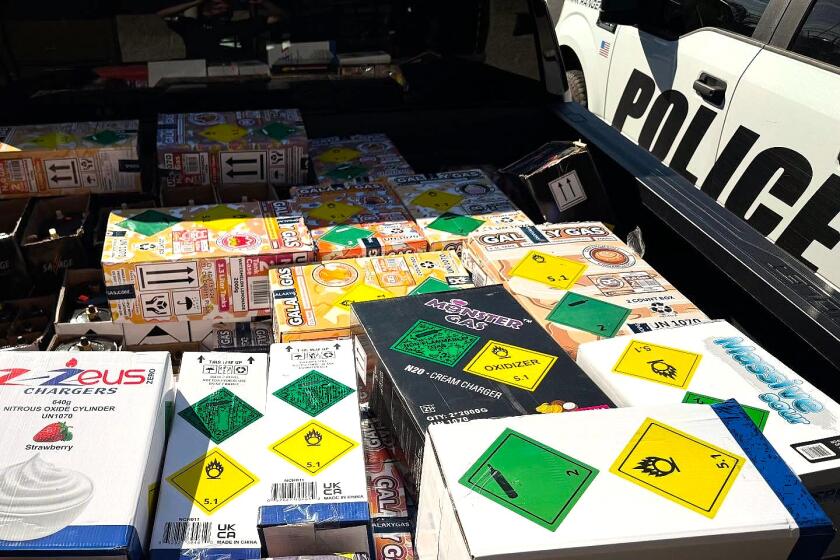‘Search and recovery’
- Share via
About two years ago, a pair that was fishing off the east jetty in Corona del Mar was knocked off by a wave and drowned. Within three days, the man’s body was found, but the woman’s was not.
Authorities hoped the body would eventually wash ashore, but it never did. Two months after that April 2007 disappearance, Orange County Sheriff Harbor Patrol divers took advantage of the calm, clear waters and went searching around the jetty.
There they found what was left of Yi Ni Kwong’s body — bone fragments no bigger than a knuckle here, half a pelvic bone and half a mandible there — hidden about six feet within the jetty rocks underwater.
That find is the epitome of what harbor patrol divers are used for — to clean up police scenes and bring closure to cases. It’s less search and rescue and more search and recovery, said the dive team sergeant, Chris Mitchell.
Once a month, the divers, the only police dive team in Orange County, suit up and head out to the ocean to fine-tune their craft.
It’s a mix of state-of-the-art technology and old-school tactics.
Technology
When it can, the dive team uses as little manpower as possible and relies on high-tech equipment.
A favorite among the divers is sonar. If possible, they use the sonar to see in about a 1,000-foot radius along the ocean floor. It blips out a signal that shows a “shadow” on their screen when it crosses something as small as a gun. In water deeper than 30 feet, the dive team will position its sonar unit below their boat. In shallower water, the sonar will actually show the surface of the water and clutter the screen, an unfortunate side effect of its precision, Mitchell said.
A mobile version of that technology is the ROV, or Remote Operated Vessel. The ROV is about the size of a car tire and comes equipped with a camera, small motors and its own sonar. It swims deeper than the divers do — their limit is about 100 feet — and can scout out potential dangers or difficulties for the team. Its only drawback is that with the center of the sonar screen consistently moving, it’s difficult for divers to pinpoint their target.
To communicate, the harbor patrol uses the Aquacom STX 101 and STX 101M, basically a radio in a suitcase. The radio helps crew members on board talk to the divers while they search. When they use it in combination with the sonar, the men on board can guide divers to their target within a foot.
Many times, divers are called to residential waters like a local pond or lake. That’s when divers have to use full-body, water- and air-tight suits and masks. Earlier this year, the divers were called to help police recover a water scoop for their Eagle helicopter that had fallen into Talbert Regional Park’s lake.
With the lake full of ducks and a polluted green, divers relied on their suits to keep them from touching or consuming any of the toxic liquid.
Techniques
The dive team uses three techniques to search the ocean floor.
At Monday’s training, they practiced circle searching, where one diver is designated as the center, or pivot point, and the other divers swim around him in half or full circles along the ocean floor. The pivot man holds a rope at least 100 feet long and distributes it to the searchers. The searchers are shoulder to shoulder and, using their forearms and hands, scrape the ocean floor in front of them while holding the rope. After they make one round at a specific distance, the pivot man gives them more rope and makes their circles wider.
“Sometimes you just got to do it the old-fashioned way,” said Frank Sheets, a retired sergeant who still dives with the team.
A play off the rope technique involves tying a line to two points, then having the divers follow the line up shoulder to shoulder while scraping against the bottom.
The third technique, the Jack Stay search, has divers go straight forward in a line, then swim back at an angle, forming two sides of a triangle. Then they go straight up from there again, making a shape like an N. This way, the group covers much of the same ground twice.
Difficulties
Monday’s training illustrated the difficulties divers can encounter, and why the team has proven valuable for police.
About three months ago, Mitchell and some of the other divers dropped an anchor off a Dana Point Harbor jetty. The 15-pound anchor is only a foot tall and about a foot and a half wide. Divers on Monday couldn’t even see a foot in front of them and had to rely on touch.
At the bottom of the ocean for three months, ocean currents buried all but the top inch of the anchor under sand.
“Imagine being in a pitch-black room and trying to find something,” said Deputy Chris Corn.
Corn found the anchor when his right hand brushed across the top of it. The stiffness of the object made him pause, and soon enough, his co-divers were working to dig up their find. Divers signal officers on the boat when they’ve found what they’re looking for by floating up a bright yellow and orange Pelican Float.
Whether an anchor, body or gun, when authorities need something that can’t be found, they call in the dive team. Divers have been called on to find drowned bodies, murder weapons off piers and in lakes and even crashed planes off the coast.
“If you can quickly and efficiently give closure to those families, that’s a big deal,” Mitchell said.
All the latest on Orange County from Orange County.
Get our free TimesOC newsletter.
You may occasionally receive promotional content from the Daily Pilot.



